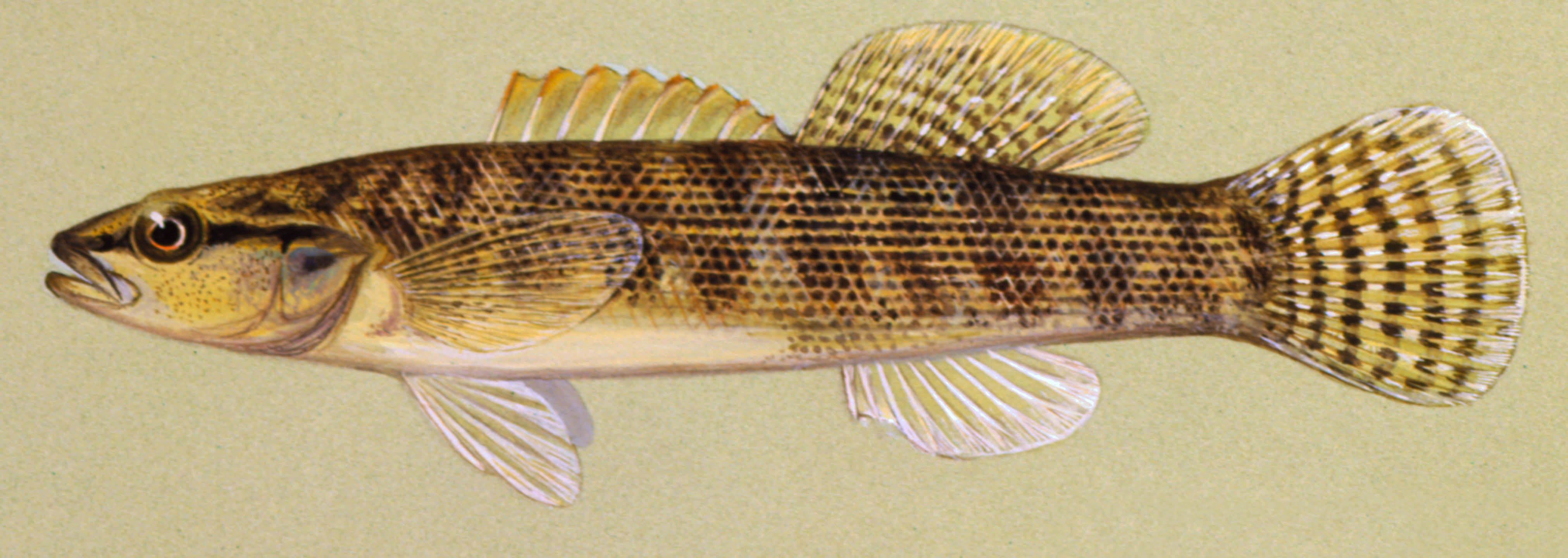Fish Iowa - Fish Species - Fantail Darter

Characteristics
A slender species usually about 2-inches long. The spinous dorsal fin is low with tips on dorsal spines forming fleshy knobs in adult males. The body is sand to brown with a small dark spot on each scale. The dorsal fin rays number 12 to 14, and the anal rays are 7 to 9. Scale numbers along the lateral line are usually more than 50.
Foods
Midge larvae and other aquatic insects; Isopods and amphipods may be important seasonally.
Expert Tip
In rivers and streams, these fish might be the "minnows" that trout, Walleyes and Smallmouth Bass are used to eating.
Details
The Fantail Darter is found in the shallow riffles or flowing pools of clear, small creeks to small rivers with permanent flow, moderate or high gradients and bottoms of gravel, rubble, flat stones or boulders. When found in large streams, it is found in shallow areas away from the main current, whereas in tiny streams, it may be found in waters that have ceased to flow. It can tolerate more turbidity and pollution than most darters, as well as very low oxygen levels. Young are sometimes found in pools and adults winter in larger and deeper waters.
Spawning starts in spring as males form and defend territories around rocks which have a slight clearance above the substrate. The spiny dorsal fin is used to clean the underside of the rock. A female moves under the rock and lays an average of 38 eggs. Spawning position is head to tail, the female inverted and the male upright, except at the moment of fertilization. About 450 eggs per female are laid, several spawnings with the same or different males are common.
Recent stream sampling information is available from Iowa DNR's biological monitoring and assessment program.
Sources:
Harlan, J.R., E.B. Speaker, and J. Mayhew. 1987. Iowa fish and fishing. Iowa Conservation Commission, Des Moines, Iowa. 323pp.
Loan-Wilsey, A. K., C. L. Pierce, K. L. Kane, P. D. Brown and R. L. McNeely. 2005. The Iowa Aquatic Gap Analysis Project Final Report. Iowa Cooperative Fish and Wildlife Research Unit, Iowa State University, Ames
Illustration by Maynard Reece, from Iowa Fish and Fishing
Distribution Map

Abundant throughout the forested regions of northeast Iowa; found often in central and north-central Iowa, particularly in the North Raccoon, Boone, Lizard Creek, South Skunk and upper Iowa River watersheds. It is one of the more abundant darters in much of its Iowa range.
See our most recent distribution data for this species on the Iowa DNR's Bionet application.
State Record(s)
No state record exists for this species
Submit your potential recordMaster Angler Catches
No Master Angler catches currently exist for this species.
Submit your Master Angler catchFish Surveys
Tip: Click Species Length by Site, then use the dropdown to filter by fish species of interest.Where this Fish Is Found
Baileys Ford
Bankston Creek
Bear Creek
Big Mill Creek
Bloody Run Creek
Bohemian Creek
Brush Creek
Buck Creek
Grimes Hollow
Hewett and Ensign Creeks (Ensign Hollow)
Little Mill Creek
Little Paint
Little Turkey River
Miners Creek
Mink Creek
Monastery Creek
Mossy Glen
North Bear Creek
North Cedar Creek
Paint Creek
Pine Creek
Ram Hollow
Sny Magill Creek
South Bear Creek
South Cedar Creek
Spring Creek
Swiss Valley Creek
Tete des Morts River
Turtle Creek
Twin Bridges
Upper Swiss Valley Creek
Wapsi River (Trout Section)
Waterloo Creek
White Pine Hollow
Yellow River (Trout Section)